October 10, 2009 by urbanwildflower
Yes, we’ve MOVED. While we are still unpacking boxes on the new site we do invite you to change your bookmarks NOW. DGBQuilts has a new home. This site will no longer be upated. Please visit the new website and blog for updates, pictures and everything else going on in the world of UrbanWildflower Dolls and Deborah Grayson Studios. We so appreciate all of the support you have given us over the last year. Peace and Blessings, Deborah

Posted in art, art quilts, handmade | Leave a Comment »
May 24, 2009 by urbanwildflower
Hi there. While the site has been quiet I have definitely been busy. Within the next few weeks I will be launching my new website: graysonstudios.com and a new blog. I am SO excited. It’s been a long time coming but CHANGE is almost here!!! The site will be more robust with beautiful new look AND a way to purchase my work. Thank you so much for your support!
PEace and BLeSSings,
Deborah
Posted in Uncategorized | 1 Comment »
February 22, 2009 by urbanwildflower
I am very excited to be a part of the Avery Research Center‘s exhibit, “Mermaids and Merwomen in Black Folklore.” To my great surprise they have even featured my quilt on their website! I was not able to make the opening but I do hope to see the show before it closes on March 31, 2009.
The name of my quilt is Olokun Kept Us. As I mentioned below, Olokun is said to be the keeper of the deepest part of the sea. She is often depicted as a mermaid. Sometimes she is described as being/connected to Yemaya. In some parts of African culture Olokun is personified in patience, endurance, observation, wisdom, history of the past and future visions. She is also often described as the protector of those Africans who were stolen during the Trans-Atlantic Slave Trade. My quilt depicts Olokun as a welcoming and watching spirit. I locate her within the deepest bluest part of the ocean. The figures depicted walking across the sky represent the ancestors who walked (or flew) back to Africa rather than be enslaved. I know, I know, I am pulling together a number of narratives within African and African American culture. I am allowed — I am an artist. (smile).
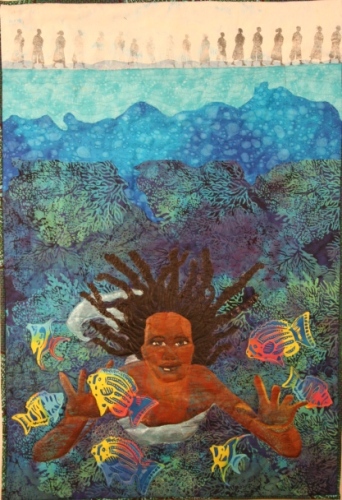
Posted in Uncategorized | 5 Comments »
January 24, 2009 by urbanwildflower
The Quilts for Obama show continues to get a great deal of buzz. I recently found out that there is a possibility that the show could be extended. Nothing has been confirmed yet but I will let you know. In the meantime, Sonji Hunt has been collecting links of the 44 artists in the show. After you have finished visiting here please take a look at Sonji’s blog to see the fabulous work of the show participants.
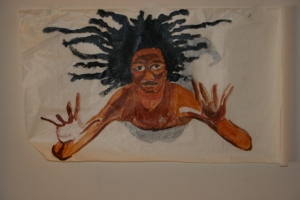
I have been working on a new piece for a show about Africa
n Merwomen and Merwomen. My quilt is called Olokun kept Us. Olokun is said to be the keeper of the deepest part of the sea. She is often depicted as a mermaid. Sometimes she is described as being/connected to Yemaya. The quilt I constructed evolved from a dream I had. I had been reading Nature’s Studio by quilt artist Joan Colvin. I admir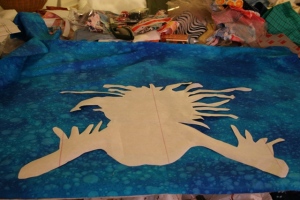 e her work and found some of her collage techniques interesting. In rendering Olokun I wanted to show her deep in the water but I also wanted her to be a part of the water. Reading Colvin’s book got me to thinking about ways to make my figure blend into the background fabric. I did not want to applique the image or have her sit on top of the fabric. I began this quilt three times before I got the effect I wanted. Here is the first “block” I created. I came up with the idea of painting Olokun on to iron on adhesive and then transfering the image onto fabric. I thought that this was one way I could get the sheer look I wanted — where the figure would look like it was emerging from and was one with the background. So, I held my breath and used a light gray colored pencil to sketch in the figure. I then painted the figure on to Heat n Bond lite with liquid acrylic paints. I let my painting dry, cut it out and got my iron out and this is what I got in my first attempt
e her work and found some of her collage techniques interesting. In rendering Olokun I wanted to show her deep in the water but I also wanted her to be a part of the water. Reading Colvin’s book got me to thinking about ways to make my figure blend into the background fabric. I did not want to applique the image or have her sit on top of the fabric. I began this quilt three times before I got the effect I wanted. Here is the first “block” I created. I came up with the idea of painting Olokun on to iron on adhesive and then transfering the image onto fabric. I thought that this was one way I could get the sheer look I wanted — where the figure would look like it was emerging from and was one with the background. So, I held my breath and used a light gray colored pencil to sketch in the figure. I then painted the figure on to Heat n Bond lite with liquid acrylic paints. I let my painting dry, cut it out and got my iron out and this is what I got in my first attempt
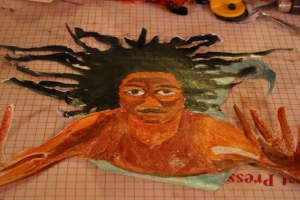
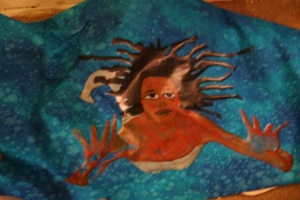
What I discovered in this process is that Heat n Bond Lite is not the correct adhesive to use for this process. I found it too plasticky. Also, the ransfer became hard and peeled in someareas. Still I felt I was on to something so I decided to try it again. In the next version I made a more detailed drawing and really focused on painting the face. This time I decided to paint on Wonder Under. Here is a picture of the painting in progress. My next post will show the steps I went through to complete the transfer and build the rest of the quilt.
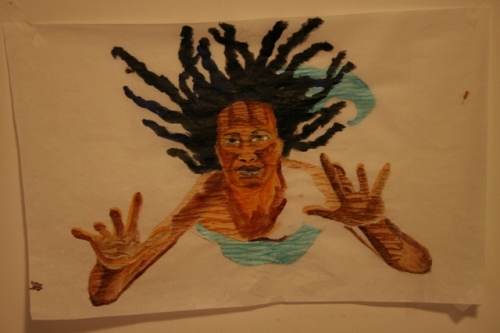
Posted in art, art quilts, creative process, painting, quilts | Tagged art, art quilts, creative process, exploration quilts, quilting, quilts, works in progress | 1 Comment »
January 17, 2009 by urbanwildflower
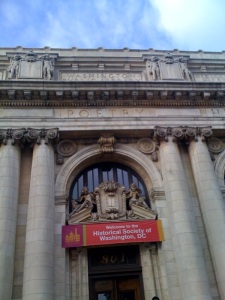
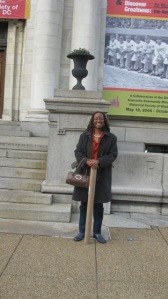
So, many of you know that I was one of the 44 artists selected to participate in the Quilts for Obama Exhibit. I am still so excited to have participated in the celebration of our 44th president in this way. I am even more excited because the exhibit took place in my home town. My family was able to attend the opening. There is a buzz in DC that I have never experienced before and it felt so good to be home. People talk about “Washington” as if it is just a place where people do politics. I know it as Washington, DC a city of neighborhoods and everyday working people. But I digress. . . .

The quilt I made for the exhibit is called “And so there is hope. There is hope.” It is made in the tradition of the Egungun costumes of the Yoruba people. When Carolyn Mazloomi called me to participate in this exhibit I had already had a sketch in my sketchbook of the quilt I eventually created. I wanted a way to pull together all of the hopes, dreams, charms and prayers I collected while working On President-elect Obama’s campaign. When doing the intial research for the quilt I learned that traditional communities of the Yoruba people honor their ancestors through the creation of Egungun costumes. The costumes are said to represent the collective force of the ancestors who bless the living. When the costume is worn, dancers spin around and the long colorful arms spin out as though the ancestors are touching us. I want President-elect Obama to feel all of our arms lifting him up in prayer, reaching out in support, digging in to do our own work. As President-elect Obama often says he can not do any of this work alone. Indeed he needs each one of us. We truly are the ones that we have been waiting for.
Statement about the Quilt:
After standing in line for 4 1/2 hours to vote, when it was finally my turn to step up to the terminal I stared at the screen for a good while before I touched it for Barack Obama and Joe Biden. As I touched the screen I called the names of family members who had not lived to see this day. This quilt is made in the tradition of the Egungun costume. It embodies prayers, ancestral spirits and of course hope.
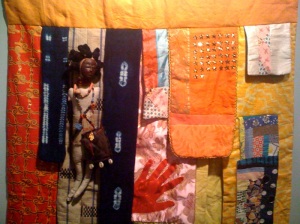
Posted in art, art quilts, creative process, handmade, quilts | 2 Comments »
January 4, 2009 by urbanwildflower
2008 Wins
- One of 44 artists selected for the Quilts for Obama exhibit at the Historical Society of Washington. The exhibit will open on Sunday January 11, 2009. Here’s a sneak peak:
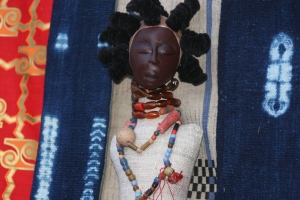
Close up from my Obama quilt for the show. The name of the Quilt is "And so there is hope. There is Hope."
_
- Finally completed the blue prints for the big Blog and website move. You will see improvements soon.
- Was the focus and featured artists of two news stories about my work
- Took three new workshops in encaustics and printmaking and met a number of fabulous artists
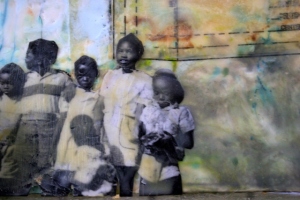

- Regularly kept my sketchbook and experimented more with COLOR and new media
- Invited to become a member of a wonderful critique group that I cannot wait to get started with
- I went to my studio everyday (even if some days all I did was to lay in the floor and take a nap)
Goals for 2009
I did a little research on the number nine. I learned that some believe that 9 holds the energy of attainment and completion and that with closure we are faced with renewal. We all know that there is no ending without a beginning. As I mentioned on the UrbanWildflowerBlog here is to a renewed passion for art and creativity.
- Get out there and enter more shows!
- Complete the big blog and website move
- update my mailing list
- get new post cards made of my work
- meet more fun artists!
- Draw everyday
- Continue to work on printmaking (this is the year of experimental screenprinting and monoprinting for me)
- Continue to play with encaustic and in acrylics (though not necessarily in the same piece!!!)
Posted in art, art quilts, artists studios, creative process, handmade, printmaking, quilts | 4 Comments »
March 6, 2008 by urbanwildflower
So I am continuing to work my way through my 2008 list of art goals that I set for myself . One of those goals was to do weekly art quilt explorations which I continue to enjoy. I admit that I have to constantly fight the desire to make each piece a perfect little piece. So keeping in mind that the operative word in this process is *exploration* here is another example of the exercise. You may remember this piece from January. I felt that I could make it a little more interesting so I cut it up. I also used oil sticks and paint to embellish the quilted surface. I got this technique from the book The Painted Quilt. Currently I am working with 4 different books: The Painted Quilt, Breakdown Printing, Finding Your Own Visual Language and Water-based Screenprinting Today. I am really excited about how my return to printmaking techniques is influencing my work. As I mention below, I have been taking an 8 week monoprinting course at the Atlanta Printmakers Studio. I have already signed up for another 8 weeks of fun and experimentation. It’s all about getting out there and trying new things. Yeah!

Posted in art, drawing, handmade, painting, quilts, Uncategorized | Tagged Add new tag | 1 Comment »
March 3, 2008 by urbanwildflower
Here is another example of a block I did using the xerox roll up technique. Several of you have written to me to ask about the steps involved. I will describe below with the assumption that you have some experience with printmaking techniques (please note that other than silk screen, I had very little experience!)
First, the image
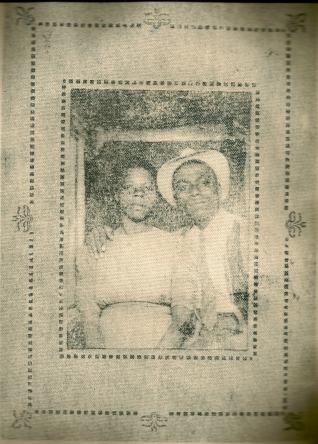
As with the image below I printed on canvas. I like the added texture and graininess that canvas adds to the image. I have not decided whether I will keep the border on the finished piece or not. Maybe I will cut it down. I don’t know yet. Anyway, here are the steps I learned to create this image.
- Make a copy of a personal photograph or copyright-free image. Enlarge the image if you choose.
- Cover the back of the copied image with a light coating of gum arabic and attach it to your plexi-glass plate (make sure that your plate has beveled edges before you run it through the press).
- once you have attached the copy to the plate cover the front of the image with a light coating of gum arabic.
- At this point I have a bucket with a large sponge on my printing table. I also roll out my ink making sure it has a nice swishing sound when I roll it out (I know, not scientific but what can I say!?)
- Take the sponge and squeeze water on the image covered with gum arabic. Blot the water with the sponge.
- Starting in the middle of the image (not on the edge where it will tear or lift the image) begin to roll ink over the copy.
- ALternately squeeze water over the image, blot and roll ink until you begin to see a build up of the ink. Then you are ready to print.
- Follow necessary procedures to protect the press before you are ready to print.
I learned this technique at the Atlanta Printmaker’s Studio from Terri Dilling. Hope I have answered your questions!
Posted in art, art quilts, creative process, handmade, printmaking, quilts | 9 Comments »
February 29, 2008 by urbanwildflower
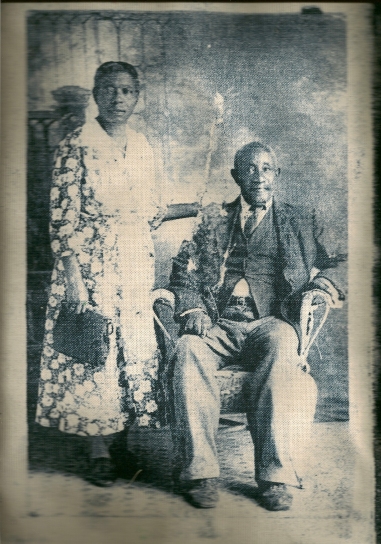
I can’t believe that we are already at the end of February. Luckily it is leap year this year or I would have missed posting in February completely. Couldn’t let that happen. February is my birthday month (Feb 19th) so I always hate to see it go. I
For the last 8 weeks I have been thoroughly enjoying the printmaking class I mentioned in an earlier post. I have been experimenting with inks, dyes and paints to create images on cloth — usually canvas. A number of these images will find their way into larger pieces. For now, they are just blocks. My work in printmaking has been specifically focused on monoprint techniques. In particular, I have done inkjet transfers, xerox transfers using wintergreen oil and a technique called xerox roll up. Xerox roll up is a faux-litho technique that uses gum arabic, water, oil-based inks and color xeroxes. In the first example I manipulated a found photo of some ancestors. I have already begun to sketch out the project I want to build around this image. In the second example I used color copies of Michelle Obama and my own mixture of blue ink to print these images on canvas.
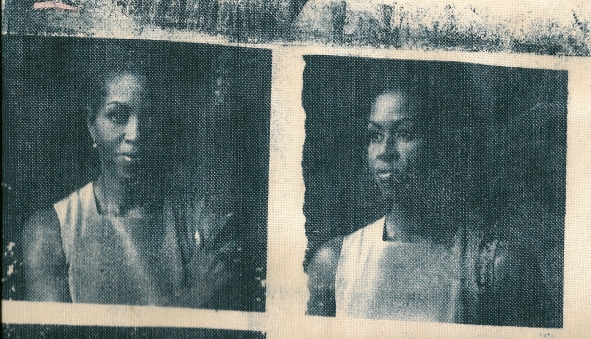
Posted in art, art quilts, creative process, handmade, printmaking, quilts | 4 Comments »
January 21, 2008 by urbanwildflower
A funny thing happened on the way to the trashcan. I found a quilt. The pieces in this exploration quilt come from scraps from other projects. I usually toss medium to large scraps in a basket on the floor near my cutting table. After (attempting to ha, ha) tidy my studio after working I thought I would dump the basket. And then all of these batik scraps and some of my hand dyed scraps fell on the floor. I began to sew the strips together, cut them and sew them together again. Hmmm, I said to myself, what would happen if . . . . and here is what I have so far . . .
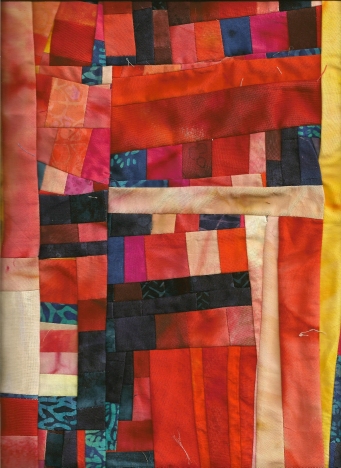
Though I have completed this exploration quilt for now I decided not to layer it piece because I think I want to grow this into a wall or lap quilt.
Posted in art, art quilts, creative process, handmade, quilts | Leave a Comment »
Older Posts »




















